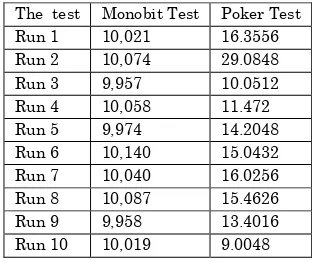ISSN 2286-4822 www.euacademic.org
Impact Factor: 3.1 (UIF) DRJI Value: 5.9 (B+)
Image Encryption by Using RC4 Algorithm
Dr. ROOJWAAN S. ISMAEL DR. RAMI S. YOUAIL SHAHAB WAHHAB
Department of Information and Communication Engineering Erbil Polytechnic University Erbil, Iraq
Abstract:
Image encryption has a wide area of application by using different encryption algorithms. Unlike the text encryption, image encryption suffers from redundancy in the plaintext which represents a problem that should be faced. In this paper, a gray-level image encryption is implemented by using RC4 algorithm. RC4 is stream cipher algorithm and it’s popular in WEP. After program execution and results assessments, we found that the encrypted image is resistant to several types of cryptanalysis, and it shows a high level of randomness in the ciphertext. Also, the encrypted image has passed the FIPS 140 randomness tests.
Key words: image encryption, RC4 Algorithm, cryptanalysis,
randomness tests
1. Introduction
In this paper, the RC4 encryption algorithm is used to encrypt an image data file (gray level image); this method is widely used in WEP. After the implementation of this algorithm; the encrypted file is analyzed and subjected to many tests. The encrypted file showed good results during these tests. Image encryption has been performed using differed methods; in [1] a new image encryption algorithm with a large pseudorandom permutation which is computed from chaotic maps is proposed. Manuscript [2] also used chaotic maps to generate long pseudorandom bits for encryptions. The improvement of the properties of confusion and diffusion in terms of discrete exponential chaotic maps, and design a key scheme for the resistance to statistic attack, differential attack and grey code attack has been performed in [3].
The rest of this paper is organized as follows: section 2 includes a description for the RC4 algorithm. In section 3, an evaluation and analyzation to the proposed method is performed together with results assessment. Finally, the paper ends with the conclusion and references.
2. Algorithm description
RC4 is a variable-key-size stream cipher developed in 1987 by Ron Rivest for RSA Data Security [4]. The same algorithm is used for both encryption and decryption as the data stream is simply XORed with the generated key, where the key is independent of the plaintext [5].
K = St
In encryption process, the ciphertext is produced by XORing the byte K with the plaintext. While in decryption process, the plaintext is re-produced by XORing the ciphertext with the byte
K. For more details about RC4 refer to [4,6,7].
3. Experimental results
A secure encryption method must be resistant to many cryptanalysis and attacks and passes several tests, such as histogram analysis and FIPS 140 testing. Our method has been applied to a gray level image JPEG ( ) file format of size 250×250 pixel, see figure 1 for the sample image.
Fig. 1: the sample image
3.1 Histogram test
The biggest problem that faces image encryption and does not exist in text encryption is the redundancy in plaintext. Therefore the used algorithm must give high distribution pixels for the ciphertext image so that the attacker cannot extract any useful information from it.
Fig.1: histogram before and after encryption
In the previous figure, the X-axis represents the pixel value, while the Y-axis represents the frequency of each pixel. From figure 1.a, we can see that the image before encryption has a certain distribution; were the pixels are intensive in the middle of the histogram. The maximum value is 9287 and minimum value is 741, the difference is 8546. While after the encryption process, figure 1.b, we notice that the pixels are normally distributed along the X-axis, the maximum value is 3550 and minimum value is 3305, the difference is 245.
3.2 The FIPS 140 tests
After the encryption process, we applied the FIPS-140 four tests to the ciphertext images [8]. Our method had passed these tests with good results.
There are four tests: Monobit, Poker, Runs tests and Long run tests. Each of the tests was designed to test the randomness of a sample sequence length of 20,000 bits as follows [1]:
1. The Monobit test: in this test we need to calculate X which represents the number of 1’s in a 20,000 bits stream, the test is passed if 9,725 < X < 10,275.
Denote g(i) as the number of each 4 bit value i where i=0,..,15. The calculate Y which is given by:
The test is passed if 2.16 < Y < 46.17.
3. The run test: the run represents the maximum sequence of continues zeros or ones. All runs of all lengths in the sample stream should be counted and stored. The test is passed if the runs of all length are within the given intervals below.
Table 1.
Run length 1 2 3 4 5 ≥ 6
Pass value 2315-2685 1114-1386 527-723 240-384 103-209 103-209
4. The Long run test: in this test, the longest run of both zero and one within 20,000 bits must be calculated. The test is passed if the longest run is less than 26.
We applied the previous tests on 50 different samples of random locations from the ciphertext image. The following table represents the results of monobit test and poker test; only ten random runs are picked up.
Table 2. The results of Monobit and Poker tests
The test Monobit Test Poker Test Run 1 10,021 16.3556 Run 2 10,074 29.0848 Run 3 9,957 10.0512 Run 4 10,058 11.472 Run 5 9,974 14.2048 Run 6 10,140 15.0432 Run 7 10,040 16.0256 Run 8 10,087 15.4626 Run 9 9,958 13.4016 Run 10 10,019 9.0048
Table 3 contains the results of run test, the number at the top of each column represents the length of the run.
Run length 1 2 3 4 5 ≥ 6 Run 1 2523 1236 633 302 156 86 Run 2 2416 1229 635 322 171 79 Run 3 2523 1231 646 324 171 73 Run 4 2528 1224 654 308 155 72 Run 5 2551 1228 608 310 158 83 Run 6 2535 1183 642 330 146 74 Run 7 2543 1250 617 312 146 77 Run 8 2544 1217 626 311 174 84 Run 9 2522 1257 614 307 154 76 Run 10 2544 1219 610 309 154 85
Conclusion
After implementing the proposed encryption scheme; we found that that encrypted image has a very high distribution calculated from histogram, all the pixels are randomly distributed and the different between the higher and lowest value is very small comparing with the difference before encryption. Also the system passed the FIPS test and the results are within the accepted ranges.
REFERENCES:
Chandra, Praphul, Alan Bensky, Tony Bradley, Chris Hurley, Steve Rackley, John Rittinghouse, James F. Ransome, Timothy Stapko, George L. Stefanek, Frank Thornton, and Jon Wilson. 2009. “Wireless Security.” Elsevier. [6] National Institute of Standards and Technology (NIST). 2001.
FIPS pub 140-2: Security requirements for cryptographic modules. [8]
Stallings, William. 2003. Cryptography and network security: Principles and practice. Upper Saddle River, New Jersey: Prentice Hall. [5]
Vacca, John R. 2009. Computer and Information Security. Handbook. Elsevier. [7]
Yoon, Ji Won and Hyoungshick Kim. 2010. “An image encryption scheme with a pseudorandom permutation based on chaotic maps.” Elsevier, 2010. [1]


